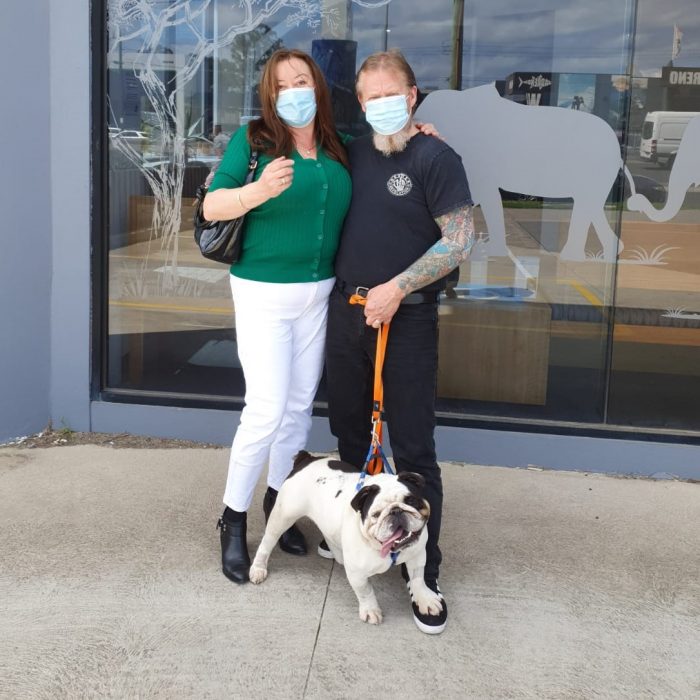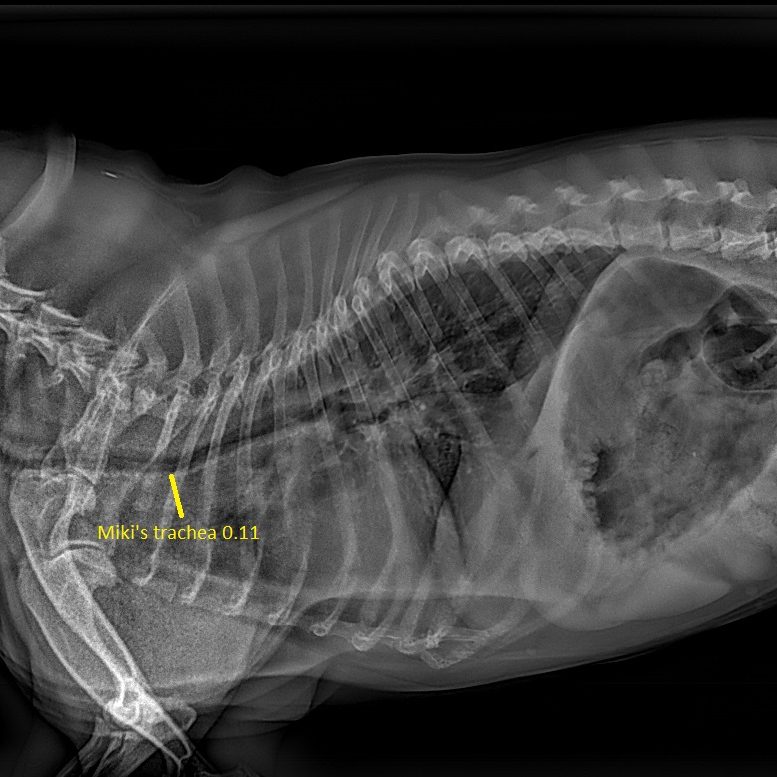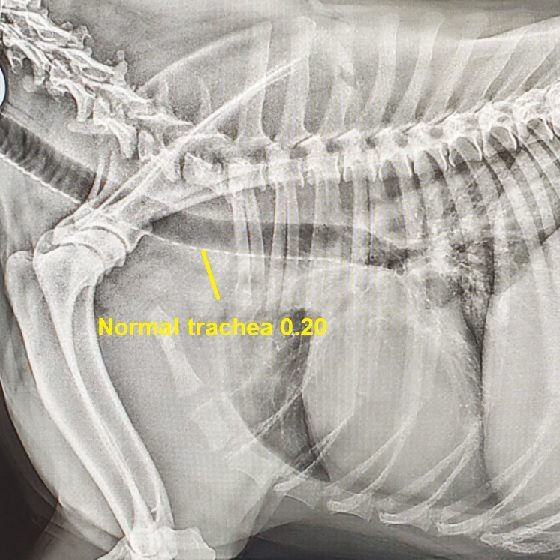Miki represents a significant problem with brachycephalic breeds, in particular in British bulldogs with hypoplastic tracheas. As we know, their excessively squashed faces cause enough welfare issues, but many dogs also have a trachea (windpipe) that is abnormally narrow which exacerbates their breathing concerns.
Miki was considered a “normal” British Bulldog by most standards – noisy, snoring a lot and struggling with exercise a little compared to normal nose dogs. However he slowly started struggling more and more coming up to 2 years of age. At 2 years and 2 months he presented to our clinic wanting airway correction, given he had suffered an aspiration pneumonia episode some months earlier, and was obviously struggling more in the warmer weather.

Every airway correction patient carries some risk of poor recovery, some potentially needing a tracheotomy tube to help them breathe post surgery, and potentially even dying post surgery. This risk increases with age, noise and other potential conditions such as laryngeal collapse, redundant pharyngeal mucosa and hypoplastic trachea. Miki had a significant hypoplastic trachea. You can see the size of his trachea here compared to normal dogs.
A normal trachea is 0.20, a grey area one is 0.16 to 0.20, and a hypoplastic one is less than 0.16.
Miki was 0.11. This carries significantly more risk with both getting through life comfortably, and potential complications associated with airway correction. Miki’s owners had not been made aware of his hypoplastic trachea prior to previous vet clinics recommending surgery. In fact, they had not been made aware of this during his long hospital stay some months prior. Not only did we have to increase the odds that Miki may need a tracheotomy tube if he was struggling post surgery, we had to increase the odds Miki may not actually survive surgery as he was older and very severe with his noise.
This was worsened when we examined Miki. Miki was a little stressed and panting hard upon admission to hospital. Stressed dogs, panting excessively pre surgery, carry a higher risk again. For this reason the option of an elective tracheotomy tube placement was discussed with his owners. By placing one before the dog recovers from the procedure, there is a reduced chance of death and a significantly reduced chance of needing 2-4 days in hospital and ICU compared to a single day. His owners elected for this option.
Despite a bit of a rough recovery, by the afternoon Miki was well enough to actually go home and have his elective tube removed the next day, already showing a significant improvement. Just two weeks later Miki’s owners were extremely happy with less snoring, less regurgitation and far less exercise noise and he was already showing improved exercise tolerance. Miki had significant improvement across all the four areas we monitor. Not all patients are so lucky.
The main lesson here is that Miki’s risks were significantly heightened by not only having a hypoplastic trachea, but by leaving surgery beyond two years of age. Surgery risk is the lowest at 10-14 months and long term results are best when airways are corrected at that time – before significant and obvious breathing concerns progress. They slowly worsen up to 24 months of age then more rapidly after that.
One of our concerns with this condition is the general veterinary professions lack of understanding of a dogs normal tracheal size, the significant problem we have with mainly British bulldogs, and the increased concerns and risks carried through life with this condition. Miki is very typical of the concerns we see with British bulldogs over 2 years of age, who would have had significantly less risks at 10-14 months, although still much higher risk that dogs with normal tracheal sizes. This significant welfare concern is often passed off as “normal for the breed” by both vets and most breeders. This is wrong. There’s nothing “normal” about a breed having to suffer significant less air access than normal nose dogs. We call on breeders to screen brachycephalics at 12 months of age and not breed form dogs with less than 0.16 tracheal sizes.
If you have a British Bulldog, please always consider a screening x-ray for hypoplastic trachea for any individual that is even remotely above average for snoring and exercise intolerance, and consider your options well before your dog reach 24 months of age, or if increased respiratory noises progress.
Please look at the videos below showing Miki’s struggles pre-surgery, then view how long his palate actually was during surgery. With a combination of hypoplastic trachea and a palate entering many centimetres down that small trachea, it’s no wonder he is breathing like this. Remember, the palate is not meant to be entering the larynx at all. Unfortunately all the dogs have palates that unnaturally extend into the larynx, to one degree or another. Please consider correcting them at desexing, or before 12 months of age.
Although we diagnose many significant hypoplastic tracheas in British Bulldogs, urging owners to ask the breeder to screen both parents usually seems to be met with little interest or concern from the breeder. Melbourne Bulldog Clinic is passionate about breeders screening for this problem at 12 months of age and not using any dog with a trachea less than 0.16 to breed from. We remain proactive and passionate about this being mandatory one day.
To Marcus and Karen and all of the team at The Bulldog Clinic,
On behalf of myself and Gary we would like to thank Dr Karen Davids for saving our bulldog Miki. The lifesaving transformation you have performed on Miki has not only changed his quality of life enormously but ours as well. To all bulldog owners we urge you to take you dog to The Bulldog Clinic in Cheltenham to have your dog assessed and treated as early as possible. We did not get Miki treated early simply as we did not know about the breathing problems of the Bulldog breed. We were unaware of this and weren’t not informed until Miki’s breathing and quality of life deteriorated to the point we thought we would loose him.Once again we would like to thank Marcus and Karen and all team at The Bulldog Clinic for saving our precious bulldog Miki.Best regards,Milena and Gary


